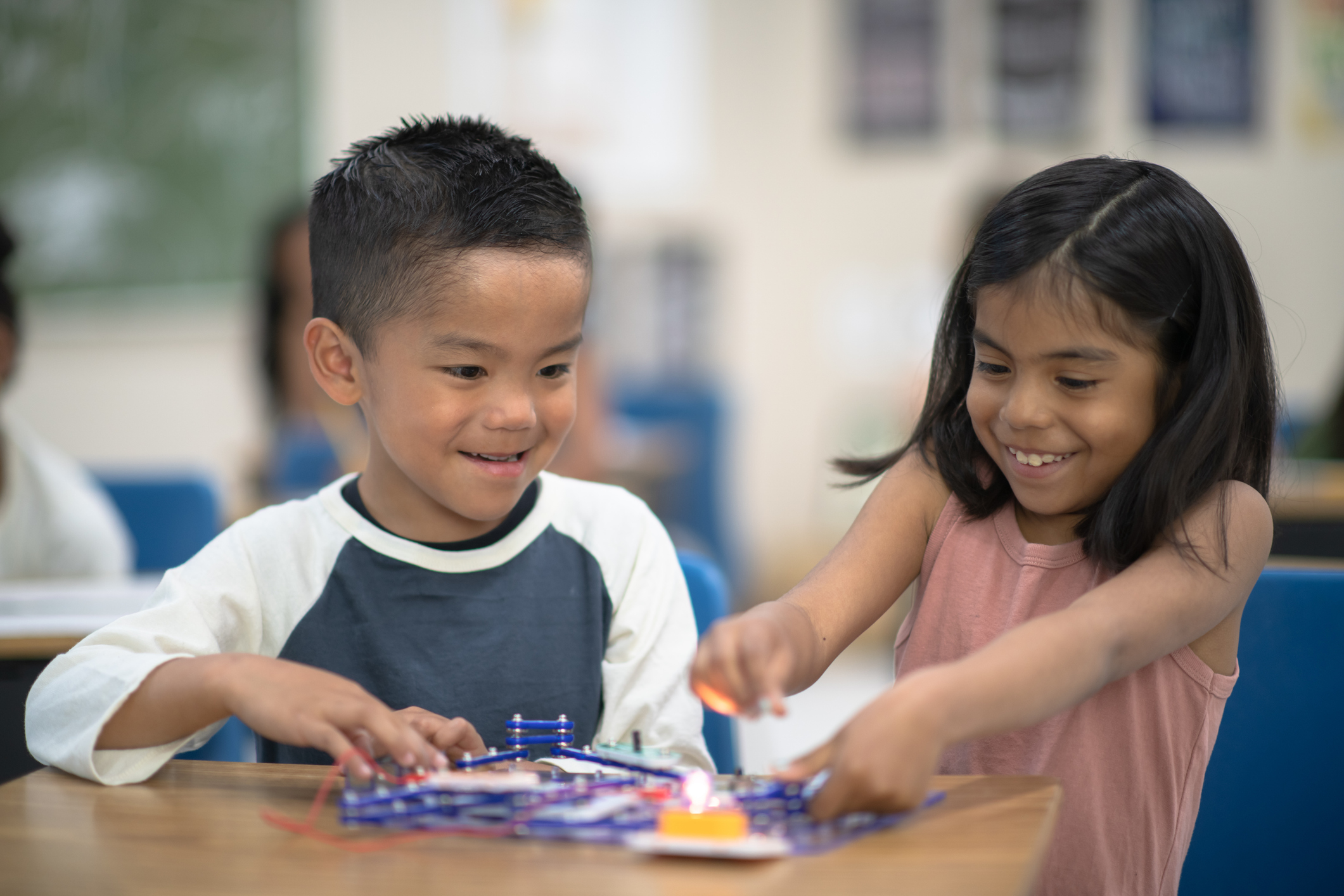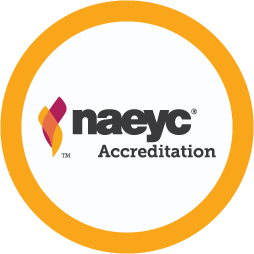Promoting Identity and Equity in STEM: Messages from the Learning Environment

You are here
To create an equitable, caring community of learners, representation matters. Years of research and high-quality practice have shown that each and every child needs to see themselves and their families regularly and meaningfully reflected in early childhood environments. This includes learning settings and experiences that incorporate STEM (science, technology, engineering, and math). The arts also play a crucial role, allowing children to express their identities and experiences creatively, as a part of an integrated approach.
Creating a STEM-rich environment with experiences that promote identity and equity is essential for fostering a sense of belonging and competence in young learners (see “STEM’s Connections to Advancing Equity” at the end of this article). This is because the messages conveyed through early learning activities, materials, and interactions can significantly impact how children perceive themselves and their potential in STEM. Indeed, every child should have access to the supports necessary to think through their hands—to show what they know, what they want to learn, and what they can do by observing and physically exploring and experimenting with the world around them. Educators can achieve this without spending limited resources on fancy kits; rather, settings can be stocked with everyday natural, found, and reusable resources (sticks, stones, leaves, buttons, fabric scraps, cardboard) and child-friendly and adaptive tools (easy grip scissors, child-safe cardboard cutters, low-temperature glue guns, hole punchers, adaptive tape dispensers, switch-activated devices).
Definitions
Equity is the state that would be achieved if individuals fared the same way in society regardless of race, gender, class, language, disability, or any other social or cultural characteristic. In practice, equity means that all children and families receive necessary supports in a timely fashion so that they can develop their full intellectual, social, and physical potential. Equity is not the same as equality. Equal treatment given to individuals at unequal starting points is inequitable. Instead of equal treatment, NAEYC aims for equal opportunity.
Studies show that attitudes form early and that positive STEM experiences can lead to increased interest, confidence, knowledge, and persistence in these fields as children grow. Educators can tap into children’s funds of knowledge to build positive beliefs related to STEM by incorporating the tinkering, making, and engineering that occur in children’s homes, neighborhoods, and communities. Families and community members can share valuable insights and inspiration, illustrating for children that everyone can be a creator and innovator in STEM fields.
Following are some key messages from a child’s perspective that early childhood educators can foster and support in their learning environments and teaching.
I Belong Here
“I see books and pictures of individuals engaged in STEM who look like me. I know I can experience success in STEM because I see people like me doing amazing things.”
As part of advancing equity, early childhood educators must ensure that all children see themselves, their experiences and contexts, and their families and communities positively reflected in learning environments and instruction. This is also part of developmentally appropriate practice. Such positive reflection fosters a sense of belonging and self-worth, which encourages children to engage confidently in their learning settings and activities.
Educators can provide STEM settings rich in representation by
- ensuring that materials reflect the backgrounds and lived experiences of all children. These should include books, posters, and educational toys. For example, Rosie Revere, Engineer is a picture book that features a girl who loves engineering. Ada Twist, Scientist is inspired by Ada Lovelace, an English mathematician, and the physicist and chemist Marie Curie. These books push back against the myth that STEM is just for boys. Posters of women and men as engineers and images showcasing both boys and girls engaged in beginning robotics activities also help children see that everyone can be scientists, engineers, technologists, and mathematicians.
- highlighting the achievements of racially, culturally, linguistically, and gender-diverse STEM professionals. Lonnie Johnson, for example, is a Black NASA engineer who invented the Nerf Super Soaker. Ellen Ochoa was the first Latina to go to space.
- using stories, videos, and guest speakers from the community to introduce children to STEM role models who represent a variety of backgrounds and lived experiences.
I Am a STEM Explorer
“When I ask questions, explore, and create, I am like a real scientist, engineer, or inventor.”
To ensure equitable early childhood education, educators must support each and every child’s developing identity as a capable, competent learner. Nurturing children’s agency involves providing opportunities for them to participate in rich, engaging play and to make choices about their activities.
Educators can encourage children’s agency in STEM by
- offering individualized, equitable opportunities for each and every child to engage in hands-on STEM activities. This includes setting up a variety of STEM experiences, such as building with blocks, exploring water and sand, and experimenting with balls and ramps. Teachers can use their observations of children’s interests to guide their planning and teaching.
- promoting a community of learners where questions and exploration are valued. For example, during a nature walk, educators can encourage children to ask questions and explore answers together. They can set up a tinkering activity where children work together to actively investigate everyday situations and objects, make predictions, and observe outcomes.
- connecting playful, STEM-rich explorations to real-life jobs and tasks. This reinforces children’s identities in these fields and helps them envision themselves in STEM roles.
My Ideas Matter
“My ideas are important. I can think of new ways to do things and share them with my peers and teachers.”
Engaging children in collaborative learning experiences is part of equitable teaching. By welcoming and integrating their ideas and experiences, teachers reinforce the value of children’s contributions and honor their individual contexts.
Educators can create environments and activities where each and every child’s ideas and contributions are valued by
- planning and scaffolding for every child’s participation. Open-ended questions encourage all children to participate in discussions and activities (“What do you think will happen if . . . ?”; “How could we solve this problem?”). Using their observations of children’s strengths, interests, and areas for growth, educators can also support children to explore and express their ideas in multiple ways.
- creating opportunities for children to showcase and use their ideas and inventions with others. For example, if children designed and created their own sports shoes from reusable materials, they could set up a shoe store in the dramatic play area that everyone could use.
- cultivating teamwork and collaboration. When children work together (building a model or prototype of their favorite playground, for instance, or creating shadows from different objects and light sources), they are able to learn with and from each other.
My Context Is Important
“I can share who I am and my experiences, and I can learn about others during our STEM activities. Our backgrounds and experiences are part of our learning!”
Educators advance equity in their learning settings when they plan and facilitate activities that promote respect and appreciation for multiple social identities. This helps children feel seen and included.
Teachers can create such equitable STEM explorations by
- integrating children’s home and community contexts into STEM activities. Educators can invite children to bring in objects from home related to their community or cultural experiences, then use those items in tinkering, making, and engineering experiences. For example, they could plan an activity where children explore the science behind making tortillas. They could introduce children to games from different cultures that involve simple machines.
- partnering with families by inviting them to share stories about their work (if they have a STEM-related job) or about everyday problems they solved using STEM skills. By offering opportunities both in-person and virtually, teachers help ensure that learning is relevant and inclusive.
I Can Overcome Challenges
“Even if something is difficult, I can keep trying and learn from my mistakes. I know that making mistakes is part of learning.”
Mistakes are an integral part of STEM. Children develop a growth mindset through experimenting, learning from each attempt, and experiencing those “aha” moments of discovery. This requires a safe, supportive learning environment, which teachers can create by
- recognizing and supporting effort and perseverance, particularly when children encounter challenges during STEM activities. For example, if children are building a block tower that keeps falling, teachers can recognize their efforts and guide them as they try new ways to make the tower stand.
- encouraging experimentation, so children feel comfortable taking chances and making mistakes. For example, at a ramps and roller station, children can test the ways different objects move. As they observe how objects roll or slide, teachers can discuss results without judgment.
- modeling self-talk and problem solving when something doesn’t work right. For example, if children are exploring light and shadows and the shadow doesn’t appear as expected, a teacher might say, “Hmm, the shadow isn’t showing up like I thought. Let’s try moving the flashlight and see what happens.”
- partnering with families to underscore effort and perseverance. When teachers send home simple STEM challenges (such as designing a paper airplane and testing how far it can fly), families are able to work together to navigate problems and figure out solutions.
Through inclusive and responsive practices, teachers can create a community of learning that equitably nurtures each and every child’s STEM identity. To begin implementing these practices, educators can ask themselves:
- How do the materials and activities reflect the identities of each and every child in my setting?
- What strategies am I using to ensure that all children can participate in STEM?
- Do I have any implicit beliefs or assumptions about children’s abilities in STEM? If so, how can I overcome them?
- How can I create more opportunities for children to share their ideas and collaborate on STEM activities?
- In what ways can I partner with families toward equitable, joyful STEM learning?
STEM’s Connections to Advancing Equity
All children have the right to equitable learning opportunities. As highlighted in NAEYC’s “Advancing Equity in Early Childhood Education” position statement, educators help children achieve their full potential as engaged learners and valued members of society when they build on each child’s unique strengths, cultures, languages, abilities, and experiences. This advances equity.
 When thoughtfully planned, STEM explorations can advance a child’s equitable learning experiences. Consider:
When thoughtfully planned, STEM explorations can advance a child’s equitable learning experiences. Consider:
- Teachers uphold the unique value and dignity of each child and family when they display and provide materials that emphasize diversity and inclusion. Books, posters, and learning materials that acknowledge similarities and differences among children provide important perspectives: Do children see themselves in the books that teachers read? Are all abilities represented in dramatic play and other areas? Do decorations and other instructional materials feature all of the communities and cultures represented in the learning setting and beyond?
- Educators develop trusting relationships with children when they embrace the languages, cultures, abilities, and other aspects of children’s identities. Teachers can learn and use STEM-related words in children’s home languages. They can intentionally incorporate STEM-related artifacts and explorations that mirror children’s backgrounds and lived experiences, along with introducing them to other ways of being and thriving in the world.
- When teachers ask families to share their STEM-related experiences, they honor families’ funds of knowledge and involve children, families, and the community in the design and implementation of learning activities.
- Through observation and planning, educators can design STEM experiences that build on children’s individual strengths and interests. For example, teachers might provide visual supports and movement while reading aloud a favorite book. They might provide extra time for sand or water exploration. This attention to strengths promotes children’s agency, or their ability to make choices about the activities they engage in and how those activities will proceed. It also scaffolds children’s learning.
- To ensure that each and every child has access to rich STEM experiences, teachers can use a multitiered system of support to collaborate with early childhood special educators and other allied education and health professionals.
Finally, teachers must thoughtfully consider how their own biases may impact the messages they send children concerning STEM. This requires asking thoughtful questions that include
- Do I believe that all the children in my setting can engage in and benefit from STEM education, regardless of their race, gender, culture, ability, or economic status?
- Do all of the children in my setting feel included in STEM activities and discussions?
- How can I engage more thoughtfully with children and families whose home languages are different from mine?
- Am I considering STEM modifications from a strengths-based view? (For example, do I think, “I can make this change to capitalize on [child’s] strengths” versus “They can’t do this; I’ll have to change it.”) What steps can I take to ensure I’m focused on all children’s strengths and abilities?
Photographs: © Getty Images
Copyright © 2025 by the National Association for the Education of Young Children. See permissions and reprints online at NAEYC.org/resources/permissions.

 This article supports the following NAEYC Early Learning Programs standards and topics
This article supports the following NAEYC Early Learning Programs standards and topics
Standard 1: Relationships
1D: Creating a Predictable, Consistent, and Harmonious Classroom
Standard 7: Families
7A: Knowing and Understanding the Program’s Families
Cate Heroman is one of the founders of Knock Knock Children’s Museum in Baton Rouge, Louisiana, renowned for its emphasis on early literacy and early STEAM education. A nationally recognized educator and author of numerous publications, she has been an early childhood educator, state administrator, trainer, facilitator, keynote speaker, and developer of curriculum and assessment materials.
